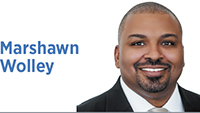Subscriber Benefit
As a subscriber you can listen to articles at work, in the car, or while you work out. Subscribe Now Black Hoosiers from around the state want their voices to be heard.
Black Hoosiers from around the state want their voices to be heard.
Housing and community violence—two issues that Black communities statewide wanted to see progress on—did not move through the session as hoped.
While plenty of bills were proposed, the vast majority did not even receive a hearing.
A survey sent out to Black Hoosiers revealed that community violence, affordable housing and mental health were among the top concerns around the state.
While community violence is a broad concept, in conversations and further outreach with community leaders across the state, we learned that responsible gun ownership—a framing of the issue that should resonate on both sides of the aisle and had some legislative proposals—did not move.
About 15 bills on housing were proposed this legislative session, and unfortunately, we did not see progress on any proposal that could impact the yawning gaps in homeownership, appraisal discrimination or even provisions to ensure habitability of properties for renters.
Indiana still remains an attractive location for out-of-state landlords to take advantage of Indiana residents by purchasing properties and charging high rents, with little accountability for maintenance.
A first-of-its-kind survey that reached 14 Black communities showed that Indianapolis Black community concerns mirrored in many respects Black community concerns around the state.
As part of a recent Community Day during the legislative session, we had the opportunity to bring Black residents, allies and accomplices to the state to commiserate about our shared concerns. Evansville City Councilor Alex Burton was most poignant when he observed that the issues impacting Evansville also impact Fort Wayne, Indianapolis and Gary.
There is quite a bit of work that needs to be done.
Only 10.9% of Black students passed the last state standardized test.
The state has a Black and white homeownership rate gap of 37.6%, according to a WISH-TV Channel 8 report, which also found homeownership rates had not improved much for Black Hoosiers over 60 years.
In the first quarter of 2023, the unemployment rate for Black Hoosiers was 6%, while the white unemployment rate was 2.5%, according to the Economic Policy Institute.
Black Hoosiers experienced the third-highest homicide rate in the country, according to the most recent Violence Policy Center 2020 report on Black Homicide Victimization in the United States.
A 2021 report by SAVI found that over a quarter of Black Hoosiers live in food deserts.
And in Indiana, African American males are more than three times likely to die by suicide than females, according to the state’s African American Mental Health website.
According to the Indiana Equity Portal, Black Hoosiers make up 31.2% of the statewide adult prison population.
The Black population of Indiana is 10.3%—there are just over 700,000 Black Hoosiers, according to the 2023 census.
These sobering statistics are among the reasons there was a collective call to action to reach across party lines and out to Black communities across the state during Indiana Black Expo’s Summer Celebration last year.
An inaugural IBE Public Policy Summit supported by the Indianapolis Urban League and the African American Coalition of Indianapolis and hosted by Crossroads Public Affairs aligned on a shared response to the aforementioned data and found a way to collaborate during this most recent legislative session.
While work remains, the idea of Black Hoosiers’ voices being heard from Muncie, South Bend, Evansville and other communities with substantial Black population is an idea whose time has come.
Black Hoosiers will continue to work to be heard at the Indiana General Assembly.•
__________
Wolley is president and CEO of Black Onyx Management Inc. Send comments to [email protected].
Click here for more Forefront columns.
Please enable JavaScript to view this content.
